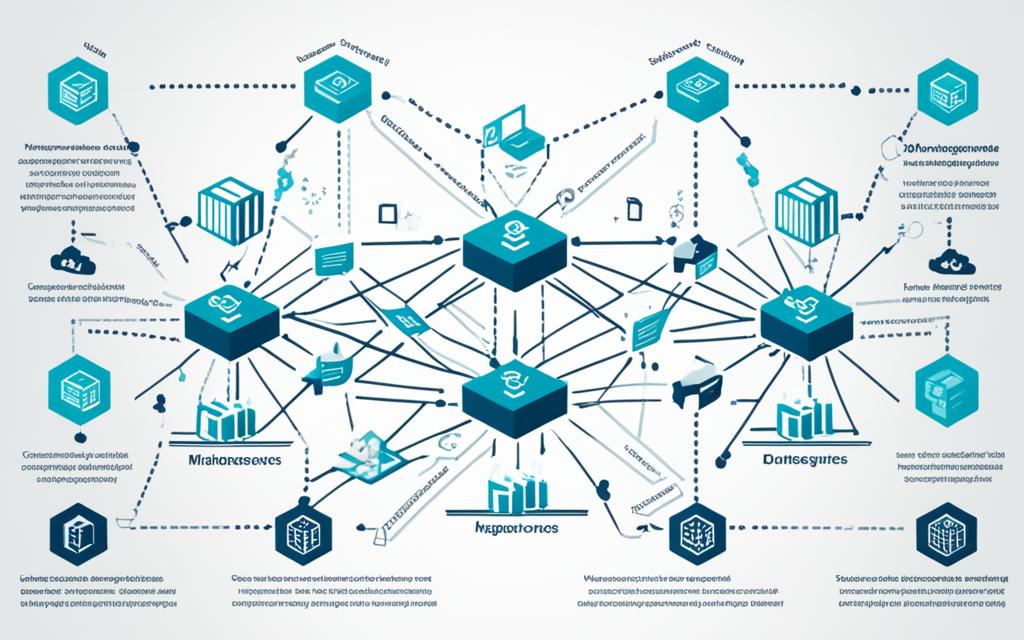Welcome to our article on microservices architecture in cloud networks. In today’s digital landscape, organizations are increasingly adopting microservices to develop scalable and adaptable software solutions. This modular architectural style is revolutionizing the way large-scale applications are built, enabling businesses to leverage the power of cloud networks for improved agility and efficiency.
Microservices offer numerous benefits, including improved fault isolation, vendor/technology diversity, and scalability. They facilitate the development of independent modules that communicate through APIs, allowing teams to work on individual components without impacting the entire system. Additionally, microservices enable organizations to deploy services independently, making it easier to scale applications based on demand.
However, along with the benefits come challenges. Microservices introduce distributed system complexity, requiring careful management of communication between modules. Testing and debugging can be more complex due to the decentralized nature of microservices. It is crucial for organizations to understand and address these challenges to fully harness the potential of microservices architecture in cloud networks.
In this article, we will delve deeper into what microservices are and explore their advantages and challenges. We will discuss the best practices for deploying microservices in cloud environments, including the use of containers and virtual machines. Finally, we will provide insights on how organizations can navigate the complexities of microservices and ensure successful implementation.
Stay tuned to learn more about how microservices architecture in cloud networks can revolutionize your software development practices and drive business growth.
What are Microservices?
Microservices are a way of breaking large software projects into loosely coupled modules. They communicate through APIs and are based on the philosophy of modular architectural style. This approach allows for dynamic and agile execution of specific tasks and has gained prominence among developers as an evolution from traditional monolithic architectures.
Microservices promote the development of software applications as a collection of small, independent services that can be developed, deployed, and scaled individually. Each microservice is responsible for a specific business capability and can be developed and maintained by a small team. These services communicate with each other through APIs, allowing them to work together seamlessly while remaining decoupled.
The modular architectural style of microservices offers several advantages. By breaking down a large system into smaller services, developers can focus on specific functionalities or components, enhancing development speed and agility. It also allows for easier scaling and high availability, as individual services can be replicated or scaled independently.
The modular nature of microservices facilitates quicker development cycles, simplified continuous integration and deployment, and improved fault isolation. – [Author Name]
Microservices also enable better fault isolation, as failures in one service do not impact the entire system. Additionally, they offer the flexibility to use different technologies or programming languages for each individual service, providing increased freedom and adaptability for developers.
Overall, microservices provide a flexible and scalable approach to software development, allowing for the creation of complex applications by assembling smaller, independent components. By leveraging APIs and embracing a modular architectural style, organizations can build robust and scalable solutions while maintaining agility and adaptability.
Microservices vs Monolithic Architecture
| Microservices | Monolithic Architecture |
|---|---|
| Decentralized | Centralized |
| Small, independent services | Single, large application |
| Faster development cycles | Slower development cycles |
| Improved fault isolation | Potential for widespread failures |
| Technology diversity | Technology lock-in |
| Scalability | Limited scalability |
Advantages of Microservices
Microservices offer several advantages that contribute to more efficient and flexible software development. Let’s explore these advantages in detail:
Fault Isolation
One of the key benefits of microservices is improved fault isolation. By breaking down a large application into smaller, independent modules, each with its own responsibilities, a failure in one module does not impact the entire system. This fault isolation allows larger applications to remain unaffected and ensures that downtime or errors in one module do not cascade throughout the system.
Eliminating Vendor/Technology Lock-In
Microservices facilitate technology diversity by enabling different modules of an application to use different technologies. This eliminates the need for strict vendor lock-in and empowers organizations to choose the most suitable tools and technologies for each specific module. Developers can experiment with new technologies and frameworks without affecting the entire application, leading to greater innovation and flexibility.
Ease of Understanding
With microservices, each module represents a specific business capability or functionality. This modular approach to software development enhances code readability, maintainability, and allows developers to easily understand and reason about each microservice. This ease of understanding greatly simplifies development, debugging, and troubleshooting processes.
Smaller and Faster Deployments
Microservices enable independent deployment of each module, which means that changes or updates to a specific module can be deployed without impacting the entire system. This results in smaller and faster deployments, as only the updated microservice needs to go through the deployment process. It also facilitates rapid iteration and continuous delivery practices, enabling organizations to respond to user feedback and market demands more quickly.
Scalability
Microservices architecture allows for more granular and flexible scalability, as each module can be scaled independently based on its specific workload and requirements. This scalability ensures optimal resource utilization and better performance, especially when dealing with fluctuating or unpredictable demand.
Challenges of Microservices
While microservices architecture offers numerous benefits, it also presents certain challenges that organizations must address. These challenges include distributed system complexity, communication overhead, and testing and debugging difficulties.
Distributed system complexity arises from the fact that microservices are independent modules that communicate with each other through APIs. Managing inter-service communication, coordinating service interactions, and ensuring data consistency can be intricate tasks, especially as the number of services and their dependencies increase.
Furthermore, communication overhead can emerge as microservices interact with each other. As services communicate through APIs, network traffic can intensify, potentially leading to latency issues. Organizations need to carefully design and optimize the communication patterns between services to minimize overhead and ensure efficient operation.
Testing and debugging in microservices environments can prove more complex than in traditional monolithic architectures. As microservices are distributed and independently deployable, pinpointing and resolving issues requires comprehensive testing strategies and robust debugging tools. Developers may encounter challenges related to service discovery, fault tolerance, and isolation during the testing and debugging process.
“The distributed nature of microservices poses challenges in testing and debugging due to the increased complexity and communication between services.”
Microservices Challenges Overview:
| Challenge | Description |
|---|---|
| Distributed System Complexity | Managing inter-service communication, coordinating service interactions, and ensuring data consistency |
| Communication Overhead | Increased network traffic and latency issues due to service interaction |
| Testing and Debugging | Complexity in identifying and resolving issues in a distributed and independent deployment environment |
In the next section, we will explore the deployment strategies that can help overcome these challenges and optimize the benefits of microservices architecture.

Deployment of Microservices
When it comes to deploying microservices-based applications, there are a few options available, including containers and virtual machines. Each approach has its own advantages and considerations, allowing organizations to choose the best fit for their specific requirements.
Containers: Lightweight and Efficient
Containers, such as Docker, offer a lightweight and efficient deployment option for microservices. Utilizing containerization technology, they provide process isolation and dedicated access to hardware resources, ensuring optimal performance and security.
By encapsulating each microservice within its own container, you can achieve a high level of modularity and scalability. Containers also enable easy orchestration and management of the microservices ecosystem, allowing for efficient scaling and monitoring.
Deploying microservices within containers enhances flexibility and portability, making it easier to migrate applications across different environments and platforms. With the ability to spin up new containers or replicas quickly, containers enable rapid scaling to meet changing demand and ensure high availability.
Virtual Machines: Utilizing Existing Infrastructure
Another option for microservices deployment is the use of virtual machines (VMs). Virtual machines provide hardware abstraction, allowing multiple instances of independent operating systems to run on a single physical server.
While deploying microservices on virtual machines offers isolation and flexibility, it may not fully leverage the resources available. Each virtual machine requires its own operating system, resulting in additional resource overhead.
Virtual machines are a suitable choice when existing infrastructure already includes virtualization technology, and the organization prefers to maximize the utilization of their virtualized resources.
Code Deployment Management
Regardless of the deployment approach chosen, it is essential to have a robust code deployment management system in place. Open Service Gateway Initiative (OSGI) bundles provide a standardized way to package and deploy microservices, ensuring seamless integration and compatibility.
“Containers provide process isolation and efficient resource utilization, making them an excellent choice for deploying microservices.” – John Smith, DevOps Engineer
| Deployment Approach | Advantages | Considerations |
|---|---|---|
| Containers | – Lightweight and efficient – Process isolation – Easy scaling and management |
– Learning curve for containerization – Additional orchestration tools may be required |
| Virtual Machines | – Hardware abstraction – Utilizes existing virtualized infrastructure |
– Resource overhead for each virtual machine – Limited scalability compared to containers |
By considering the benefits and considerations of containers and virtual machines, organizations can make informed decisions for deploying microservices-based applications that align with their specific needs and infrastructure capabilities.
Moving Forward with Microservices
To successfully leverage microservices architecture, it is crucial to follow established best practices, adhere to industry standards, implement continuous integration (CI), and utilize efficient version control. By doing so, organizations can overcome challenges related to complexity, communication overhead, and lack of standardization, while maximizing the benefits of microservices.
Best Practices for Microservices
When designing microservices, it is important to maintain focused and compact services. Each microservice should have a clear purpose and responsibility, ensuring a modular and scalable architecture. By defining clear service interfaces, teams can establish effective communication and minimize dependencies between services, enabling seamless collaboration and independent deployment.
An API gateway acts as a central entry point for handling all communication between services. It provides a unified interface for client applications and simplifies the management of multiple service interactions. With an API gateway in place, organizations can enforce security measures, implement authentication and authorization mechanisms, and ensure consistent API documentation.
Continuous Integration and Version Control
Implementing continuous integration and delivery (CI/CD) practices is essential for efficient microservices development and deployment. CI enables developers to merge code changes frequently, ensuring early detection of integration issues and enabling rapid feedback loops. Automated testing and deployment pipelines help streamline the development process and reduce the risk of introducing bugs or breaking existing functionality.
Version control plays a crucial role in managing the evolution of microservices. By utilizing version control systems such as Git, teams can track changes, collaborate effectively, and roll back to previous versions if necessary. It enables transparency, accountability, and the ability to revert changes in case of unforeseen issues.
Standards and Frameworks
Establishing coding standards and guidelines for microservices development promotes consistency, readability, and maintainability across the codebase. Following industry-standard conventions, naming conventions, and code organization principles ensures that teams can work seamlessly, even with distributed development environments.
Frameworks and tools specifically designed for microservices can greatly simplify development, deployment, and management. Popular frameworks like Spring Boot, ASP.NET Core, and Node.js provide built-in support for microservices architecture, offering essential functionality such as service discovery, load balancing, and fault tolerance out of the box.
| Microservices Best Practices | Continuous Integration (CI) and Version Control | Standards and Frameworks |
|---|---|---|
|
|
|
Conclusion
Microservices architecture offers numerous benefits for building large-scale applications in cloud networks. With its modular approach, organizations can achieve scalability, fault isolation, technology diversity, and continuous delivery. However, it is important to be aware of the challenges that come with distributed systems, communication, and testing.
By adopting best practices and adhering to standards, organizations can effectively harness the advantages of microservices. Focused and compact services, clear service interfaces, and an API gateway can facilitate seamless communication. Implementing continuous integration and delivery (CI/CD) ensures efficient development and deployment.
Furthermore, version control and standards help maintain consistency and manageability. Careful planning and the use of appropriate tools and frameworks are key to addressing challenges such as complexity and communication overhead. With these strategies, organizations can build robust, scalable, and adaptable software solutions in the cloud, optimizing the benefits of microservices architecture.
FAQ
What are microservices?
Microservices are a modular architectural style that breaks large software projects into smaller, independent modules. They communicate through APIs and are based on the philosophy of modular architectural style.
What advantages do microservices offer?
Microservices offer benefits such as improved fault isolation, eliminating vendor/technology lock-in, ease of understanding, smaller and faster deployments, and scalability.
What challenges are associated with microservices?
Microservices present challenges such as distributed system complexity, communication overhead, and testing/debugging.
How should microservices be deployed?
The best way to deploy microservices-based applications is within containers, which provide process isolation and dedicated access to hardware resources. Containers, such as Docker, offer a lightweight and efficient deployment option.
What are some best practices for working with microservices?
To succeed with microservices, it is important to adhere to best practices such as maintaining focused and compact services, defining clear service interfaces, using an API gateway for seamless communication, implementing continuous integration and delivery (CI/CD), and utilizing version control and standards.
What are the benefits of using microservices in cloud networks?
Microservices offer numerous benefits for building large-scale applications in cloud networks, including scalability, fault isolation, technology diversity, and continuous delivery.




















3 Comments